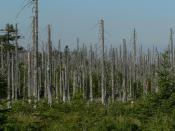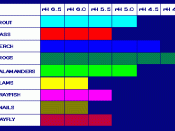Acid rain is rain that is more acidic than normal. Acid rain is a complicated problem. Primarily caused by air pollution, acid rain\'s spread and damage involves weather, chemistry, soil, and the life cycles of plants and animals on the land and in lakes and streams. This form of air pollution is currently a subject of great controversy because of its worldwide environmental damages. For the last ten years, this problem has brought destruction to thousands of lakes and streams in the United States, Canada, and parts of Europe.
Scientists have discovered that air pollution from the burning of fossil fuels is the major cause of acid rain. Power plants and factories burn coal and oil. Power plants use that coal and oil to produce the electricity for our homes and to run our electric appliances. We also burn natural gas, coal, and oil to heat our homes.
The smoke and fumes from burning fossil fuels rise into the atmosphere and combine with the moisture in the air to form acid rain.
The main chemicals in air pollution that creates acid rain are sulfur dioxide and nitrogen oxides. Acid rain usually forms high in the clouds where sulfur dioxide and nitrogen oxides react with water, oxygen, and oxidants. This forms a mild solution of sulfuric acid and nitric acid. Sunlight increases the rate of most of these reactions. Rainwater, snow, fog, and other forms of precipitation containing those mild solutions of sulfuric and nitric acids fall to the earth as acid rain.
Water moves through every living plant and animal, streams, lakes, and oceans in the hydrologic cycle. In that cycle, water evaporates from the land and sea into the atmosphere. Water in the atmosphere then condenses to form clouds. Clouds release the water back to the earth as rain,


